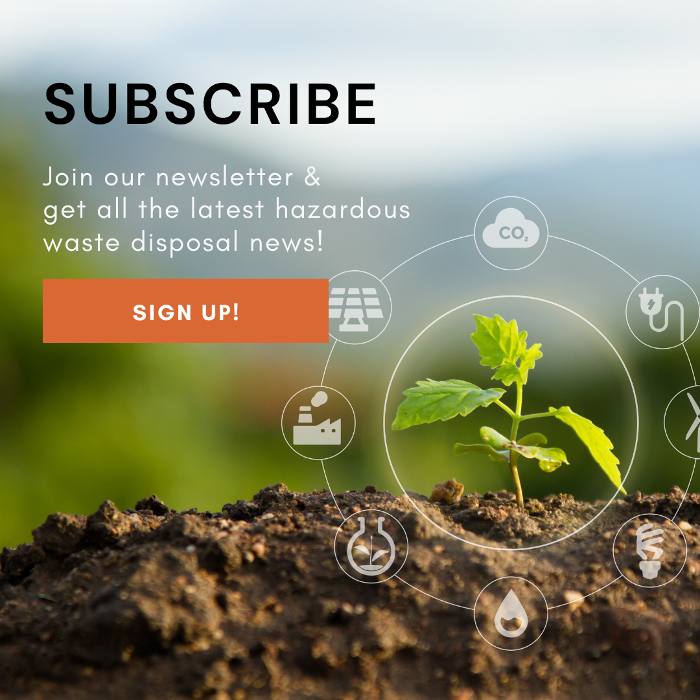Helping both emergency responders and transportation workers quickly identify potential risks is critically important in today’s busy landscape of interstate travel.
Hazmat placards play a crucial role in accomplishing this by ensuring the safe transportation and handling of hazardous materials. Although these signs are designed to simplify the identification of hazards, they are part of a complex system that involves regulations, classifications and many considerations.
Their use of colors, symbols and numerical codes convey important information about the type of hazard posed by the material. They follow guidelines established by various regulatory bodies in the United States and worldwide, including the Department of Transportation (DOT) and the International Maritime Organization (IMO).
If your business generates waste that must follow proper hazardous waste disposal laws, the use of these placards plays an important role in compliance and safety. Let’s dive into the different placards and explore best practices for their effective use so you can ensure the safe transportation and handling of hazardous materials.
Hazmat Placards
Explosives (Class 1)
Class 1 placards indicate the presence of explosives, and this category is further divided into multiple divisions based on the level of danger. These six divisions help identify the type of explosive, such as a substance that poses a mass explosion or a non-mass explosive with a projection hazard.
These placards typically feature a prominent orange background with a black explosion symbol in the center. Examples of dangerous goods falling under this category include dynamite, fireworks, ammunition and blasting caps.
Gases (Class 2)
Placards in this category identify materials that are gases, such as flammable gases, non-flammable gases and toxic gases. Placards in this category are primarily color-coded with green, red or yellow backgrounds and may include symbols representing specific gas properties.
Examples of substances falling under this category include propane (flammable gas), nitrogen (non-flammable gas) and chlorine (toxic gas).
Flammable Liquids (Class 3)
Flammable liquids placards are used for materials that are highly flammable and pose a fire hazard. These placards feature a red background with a symbol indicating flames. They also indicate more details about the substance, including whether it is gasoline, combustible or fuel oil. Examples of substances falling under this category include gasoline, ethanol and acetone.
Flammable Solids (Class 4)
Placards in this class indicate materials that are easily ignited and can catch fire. Placards in this class typically feature a flame symbol, though the color may vary. Spontaneously combustible substances will feature a half-red and half-white background, while flammable solids feature red and white stripes. Substances that are dangerous when wet feature a blue background.
Examples of substances falling under this category include matches, alkali metals, metal powders, calcium carbide, and sodium batteries and cells.
Oxidizers and Organic Peroxides (Class 5)
Class 5 placards are used for materials that release oxygen or are capable of causing or contributing to combustion. These placards often have a yellow background with an oxygen symbol, though organic peroxide features a half-red, half-yellow background.
Examples of substances falling under this category include hydrogen peroxide (oxidizer) and tert-butyl hydroperoxide (organic peroxide).
Poisonous and Toxic Materials (Class 6)
Placards in this category indicate materials that are poisonous or toxic if inhaled, ingested or absorbed through the skin. Placards in this category are usually white with a skull and crossbones symbol. Examples of substances falling under this category include hydrogen cyanide (poisonous gas), arsenic (toxic solid) and chlorine gas (toxic gas).
Radioactive Materials (Class 7)
These placards are used for materials that emit ionizing radiation. These placards are typically yellow and white with a radiation symbol. Examples of substances falling under this category include uranium, cobalt-60, and medical isotopes used in nuclear medicine.
Corrosive Materials (Class 8)
Placards in this class identify materials that can cause severe damage to skin, eyes or other materials they come into contact with. Placards in this class are typically white with a black corrosion symbol. Examples of substances falling under this category include sulfuric acid, sodium hydroxide (caustic soda) and hydrochloric acid.
Miscellaneous Hazardous Materials (Class 9)
This category is used for materials that do not fit into the other classes but still pose a hazard during transportation. This category encompasses a wide range of substances, so placards may vary. However, one of the most frequent designs used in this category is a white background with black and white stripes in the top corner.
Examples of substances falling under this category include asbestos, dry ice and lithium batteries.
Best Practices For Hazmat Placards
Adhering to best practices for hazmat placards helps ensure that everyone involved in the transportation and handling of these materials is well-informed and safe. Here are some essential best practices to follow:
of these materials is well-informed and safe. Here are some essential best practices to follow:
- Proper Placement: Always place hazmat placards in accordance with state and federal regulations. They should be easily visible from a distance and positioned on the vehicle or container in a way that is unobstructed by other objects or signage.
- Correct Selection: Choose the appropriate hazmat placard that accurately reflects the material being transported or stored. Use the proper class, division and identification number to provide precise information about the hazard.
- Consistency: Maintain consistency in the design and size of placards to ensure they are recognizable and compliant with regulations. Placards should be of a consistent size, shape and color.
- Secure Attachment: Ensure that placards are securely attached to the vehicle or container. Placards should be affixed in a manner that prevents them from becoming detached during transportation, even under adverse conditions.
- Readable Text: The text and symbols on Hazmat placards should be legible from a reasonable distance. Regularly inspect placards for fading, damage or wear and replace them as needed.
- Emergency Information: In addition to placards, provide emergency contact information and response instructions for hazardous materials. This information should be easily accessible to emergency responders in case of an incident.
- Training: Train all personnel involved in the transportation and handling of hazardous materials on the proper use and significance of hazmat placards. This includes drivers, loaders and emergency responders.
- Documentation: Maintain accurate records of the hazardous materials being transported, including the specific placards used, their locations and any changes during transportation. Documentation helps ensure compliance and aids emergency responders in case of an incident.
- Compatibility: Ensure that hazardous materials are stored and transported in containers and vehicles that are compatible with the placarded materials. This includes considering the segregation of incompatible materials.
- Inspection and Maintenance: Regularly inspect and maintain placards, containers and vehicles used for transporting hazardous materials. Address any issues promptly to prevent safety hazards.
- Security: Pay close attention to the security of hazardous materials. Prevent unauthorized access and potential theft or tampering with placarded materials.
- Regulatory Compliance: Stay up-to-date with local, national and international regulations governing hazmat placarding and transportation. Regulations can change, so ongoing compliance is essential.
- Communication: Encourage clear communication among all parties involved in the transportation process. This includes sharing information about the placarded materials with relevant personnel and authorities.
Hazmat placards play a crucial role in this process by providing essential information at a glance. By following these best practices, individuals and organizations can contribute to safer transportation and handling of hazardous materials, reducing the risk of accidents and ensuring a prompt and effective response in case of emergencies.
A Trusted Partner For Disposal
When your waste is on its way to a hazardous waste disposal center, it's imperative that any hazardous waste disposal companies you are considering are well-versed in labeling and placarding and adhere to the best practices for their use.
This not only ensures compliance with hazardous waste disposal laws but also guarantees the safety of both those handling the materials and the environment.
With hazmat placards serving as a vital component of the transportation process, selecting a knowledgeable and responsible transportation provider becomes paramount for a seamless and secure journey from your facility to the disposal center.


Comment